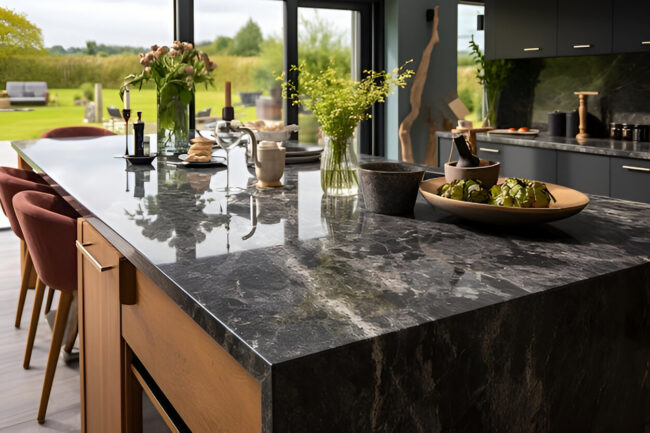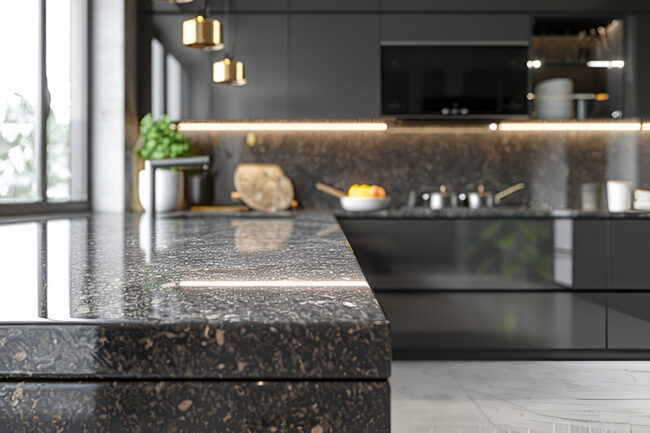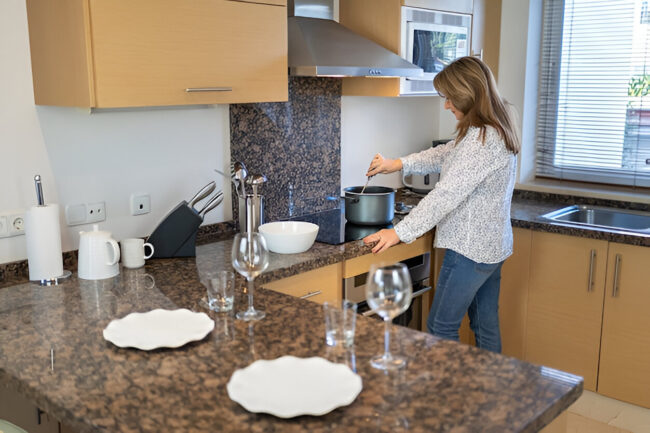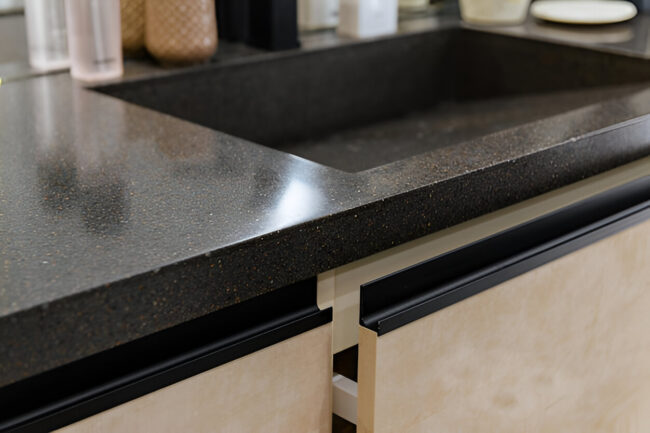
Granite countertops are a favorite in many kitchens thanks to their stylish look, solid strength, and long-lasting surface. You just need to be clear about the actual costs of a granite countertop before you choose one for your home. The price can swing quite a bit depending on multiple factors we will go over below, including color, thickness, and the market you live in.
In our guide on the cost of granite kitchen countertops, we will break down the price per sq ft, as well as a plan to develop your budget in Columbus, Ohio. This resource is intended to serve you whether you are doing a full kitchen remodel or just changing the counters.
What Is Granite and Why Is It Popular
Granite is a hard, natural stone that forms deep in the earth over time as melted rock cools and solidifies. When molten rock cools and hardens, granite is formed. This is one reason granite is so durable. It does not scratch easily and can resist heat, making it a great choice for a kitchen.
People love granite for its beauty. Each slab has its special look, with different colors and natural patterns that make it one of a kind. There are many colors (or shades) of granite. For example, you have black, white, gray, gold, and even blue. So, finding a granite color that matches your kitchen style is easy.
Average Cost of Granite Countertops
Granite countertops can be costly, but the price depends on many things like size, style, and where you buy them. Your kitchen size, granite type, and your location would be the top three factors. Let’s break this down.
Price Range Per Square Foot (Basic to Premium)

Granite is usually priced per square foot, meaning the pricing is based on the amount of stone you need. Learn more about the full cost breakdown of granite countertops in our Granite Countertops Cost guide.
Basic granite is priced from about $40 to $60 per square foot. These include common colors and simple patterns.
Mid-range granite usually costs between $60 and $100 for each square foot, depending on the style and quality you choose. These slabs may include more detail and/or come from a unique location.
High-end granite can cost between $100 and $200 for each square foot, depending on the style, color, and rarity of the stone. These stones may have uncommon colors, patterns, and may be less common.
Pricing is usually for the slab and basic installation, but may not include add-ons like custom edges and cutouts.
Cost Range: Small, Medium, and Large Kitchens
Here’s a ballpark cost estimate grouped by kitchen size:
Small Kitchen (25 square feet of countertop)
- Cost: $1,000 to $2,000
- Best for apartments or small homes
- You may be able to save by using leftover granite pieces (remnants)
Medium Kitchen (40 square feet)
- Cost: $2,000 to $4,500
- Average size for many homes
- Price varies depending on the type of granite and extras, such as sink cutouts
Large Kitchen (60+ square feet)
- Cost: $4,500 to $8,000 or more
- More stone and labor for larger kitchens
- Cost escalates quickly for rare granite and unique finishes
Factors That Impact Granite Countertop Costs

Many things can affect how much you’ll pay for granite countertops, from the type of stone to the size of your kitchen. Let’s explore the most important factors that could increase or decrease the cost.
Type of Granite (Normal vs. Uncommon Colors and/or Patterns)
Not all granite looks alike. Some are simple, normal colors, like white, gray, or black, which are easily sourced and inexpensive.
Some granite is an uncommon color, such as blue, green, or gold, with a bold pattern, and that is difficult to source from special locations. These are more expensive. Granite with unusual colors or one-of-a-kind patterns often costs more because it’s less common and stands out in looks.
Thickness of the Slab
- Granite slabs vary in thickness. Granite countertops usually come in a few standard thickness options to choose from.
- 2cm (just under ¾ inch) is thinner and lighter, and is susceptible to needing support
- 3cm (just under 1¼ inches) is thicker and stronger, thus dramatically more common
While thicker slabs provide a better look and are more durable, they do carry a higher cost. You are also paying for additional labor when installing thicker slabs, as they will weigh more.
Edge Style (Simple vs. Decorative)
There are many different ways your countertop edge can be cut.
Simple edges, such as straight edges and eased edges, will be less expensive.
Decorative edges, such as ogee, bullnose, or waterfall styles, will be more expensive.
Fancy edge work takes added time to build and requires skill, so you can expect the price to be higher as the design gets more complex.
Finish Type (Polished, Honed, Leathered)
Granite surfaces can have different finishes:
- Polished: Shiny and smooth (the most common)
- Honed: Soft and matte (not shiny)
- Leathered: textured, slightly rough
Polished granite is often more affordable because it’s the most popular and commonly chosen finish for countertops. However, honed or leathered finishes require additional manufacturing work and will usually cost more depending on the stone.
Location (Local Prices and Availability)
Prices also vary by location. Some areas have easy access to granite and are therefore less expensive than areas that must ship granite in from afar. From here, shipping costs to your location will vary based on the stone, which also affects the budget.
Local labor prices affect the overall price for granite, too. If labor workers charge higher labor prices in your area, then your installation price will also be higher.
These all factor into what you might pay for granite countertops. Being aware of all of this will help you make intelligent decisions and stay on your budget.
Labor Costs
When it comes to installing granite countertops, a fair amount of time, tools, and skill are required. The rate for labor is typically between $35 and $85 per hour, depending on your location and the company you hire.
This should include labor for measuring, cutting, and installing the granite on your kitchen cabinets.
There may be additional charges for specific aspects of the job. For example, creating holes for sinks or cooktops. If the installer determines you have unlevel cabinets, they may have to charge extra to level them first.
In total, the installation could cost $1,000 to $3,000 or more (and most likely more), depending on the size of your kitchen and what the installer needs to do. Try to get at least a couple of quotes, and ask each installer exactly what their quote includes so that there are no surprises.
Additional Costs to Consider
When it comes time to plan your granite countertop purchase and installation, it’s so easy to only focus on the stone and installation. But there are also several additional costs to remember.
First, if you have old countertops installed already, you’ll need to strip and dispose of them. This could potentially cost you about $100 – $300, depending on the square footage and material of the old countertop. Some installers will include this in their price, but others will charge you separately for it.
Next, granite must be sealed to keep it protected from stains. Most installers will seal the tops once, but you may need to reseal every year or two years. A sealing kit or service could cost you between $50-200.
Additionally, if you want special cutouts (on any countertops) for top-mount sinks, faucets, or outlets, those will also potentially add to the total cost. Similarly, delivery fees and custom design work can increase the overall cost of your granite.
All of these small extras can add up. It is a good idea to plan for these additional costs in advance.
Ways to Cut Costs on Granite Countertops

- Choose common granite color options such as black, white, or gray—it will cost less than rare colors.
- Select granite slab thickness as 2 cm thick ex, standard, to avoid thicker and therefore more costly slabs.
- Use simple edge styles, such as straight or eased edges, to avoid additional labor costs.
- If you are using granite remnants on a small area, such as bathroom counters or kitchen islands.
- Use a local supplier to avoid higher shipping or delivery costs.
- Obtain price quotes from multiple installers and compare them.
- Consider buying during a sale or during a non-busy time of year to save on both product and labor costs.
- Do not consider extras such as expensive finishes or custom shapes unless necessary.
- Ask if sealing is included in the installation cost to make sure you don’t pay that charge separately.
Granite vs. the Other Choices
Granite is a tough and lovely choice, but it isn’t the only choice for countertops. Let’s look at how granite stacks up to the other popular choices, quartz, laminate, and marble.
Granite vs. Quartz
- Granite forms naturally in the earth, while quartz is created using crushed stone mixed with resin in a factory.
- Quartz has more colors to choose from, and quartz is non-porous (doesn’t need sealing).
- Granite needs sealing, but it can take more heat than quartz.
- Their prices are usually in the same general range, but quartz can be more expensive when going with a premium name.
Granite vs. Laminate
- Laminate is made by layering paper and plastic over a pressed wood base.
- Laminate is less expensive than granite but not as durable or resistant to heat.
- Laminate is easy to install and has many choices for colors, but it has a shorter longevity than granite.
- Granite provides more value for your home than laminate does.
Granite vs. Marble
- Both are natural stones; marble is softer and might stain or scratch more easily.
- Granite is better for more active kitchens because it’s stronger and requires less care than marble.
- Marble provides a classic, higher-end value but requires more care and maintenance than granite.
- Generally, marble is more expensive than standard granite.
| Material | Cost per Sq. Ft. | Durability | Maintenance | Looks |
| Granite | $40 – $200+ | Very Durable | Needs sealing | Natural, unique |
| Quartz | $50 – $150+ | Very Durable | Low maintenance | Uniform, modern |
| Laminate | $20 – $50 | Low to Medium | Easy, but less lasting | Many styles available |
| Laminate | $60 – $250+ | Medium | High maintenance | Elegant, soft look |
Is Granite Worth the Price?
Granite is probably worth every penny, in a location like Columbus, Ohio, because it provides an excellent combination of beauty, durability, and resale value. Mid-range granite has a price point of around $50-$80 per square foot in Columbus, but you’re paying for a surface that is resistant to daily abuse, the heat from cookware, and regular cleaning.
The natural patterns in granite make your kitchen look more interesting, and they can catch the eye of home buyers in Central Ohio. If the slab is properly sealed and taken care of, your countertops in Columbus, Ohio, could last a lifetime. This is a worthy investment that balances initial cost with long-term value.
Conclusion
Granite countertops are a strong, stylish, and lasting choice for your kitchen. While the cost can be high, it’s often worth it for the beauty and value it adds to your home. By understanding the prices, extra costs, and ways to save, you can make a smart choice that fits your budget. If you live in places like Columbus, Ohio, granite is also a great way to impress future home buyers.
